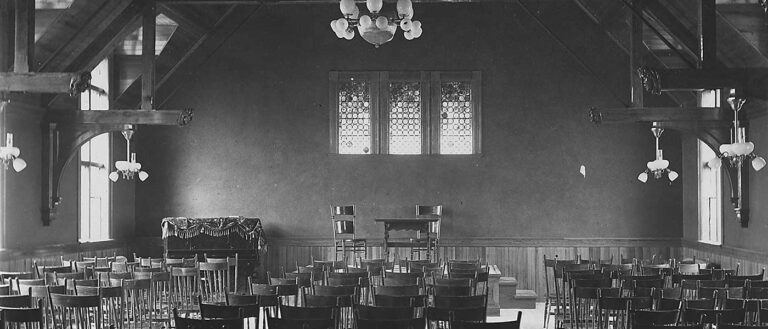The Daily has partnered with University Archives to shed light on Case Western Reserve University’s history each month. Follow The Daily to get your fill, and check out Digital Case to find even more information.
Since its opening in 1898, Eldred Hall has served as a homebase for performers from various theater-oriented groups and departments on campus. But when renovations on the Maltz Performing Arts Center brought all theater resources under one roof, Eldred Hall was left empty and unused for over a year.
This fall, students will breathe life into Eldred Hall once again—this time enjoying the building as an accessible, student-focused space. Learn more about the history of Eldred Hall as it prepares for its second act.
Eldred Hall’s Founding
At the turn of the 19th century, Eldred Hall was created to serve as a spiritual center of student life for the former Adelbert College of Western Reserve University. The building was named after Henry B. Eldred, a local minister and friend of the university, following his donation of $15,000 intended for a Youth Men’s Christian Association (YMCA) in 1897. Additional donors to Eldred Hall included President Charles F. Thwing and Monroe M. Curtis, a faculty member.
Construction began the same year under the lead of architect William Warren Sabin and finished in 1898, resulting in a building consisting of three stories made with oak, maple and Georgia pine finish. In addition to assembly, meeting and reading rooms, the building made its debut with a snack bar, barbershop, auditorium and English Gothic-style basement.
For a while, Eldred Hall was mainly occupied by the YMCA and Student Army Training Corps until the Sock and Buskin Club, a company of student actors, took over. These actors initiated theater culture on the Western Reserve University campus by staging student-written revues, popular “quick hit” comedies, and Shakespearean plays. At the same time, Flora Stone Mather College had a new group of young actresses taking to the stage as the Curtain Players. By the 1920s, the Eldred Players, a community group of actors, joined the drama clubs providing theater for Cleveland.
A Theatrical Past
As theater became more prevalent in Eldred Hall, it also grew in popularity across the campus. By 1931, Barclay Leathem, an English professor with a law degree from WRU, founded the Department of Drama and Theater to make theater no longer just an extracurricular activity. Originally, the department offered theater courses at the graduate level and established the group the University Players; it would take several more years for undergraduates to take those same courses.
Leathem became a leader in theater education until his retirement in 1971. Some of his contributions to theater at the university include establishing one of the first college courses on television, establishing working relationships with local theaters, including the Cleveland Play House and Karamu House, bringing dance to Case Institute of Technology, and creating a summer theater group called the Barn Players.
Another notable graduate includes Nadine Miles (FSM ’36), who joined Leathem in the department after starring on Broadway until her retirement in 1972. She became one of the university’s (and Cleveland’s) main artistic forces in theater, directing such productions as The Fly and T.S. Eliot’s Murder in the Cathedral.
Looking Ahead
Eldred Hall—one of the few remaining structures from Adelbert College—has experienced significant alterations and modifications since its original opening—from a new sub-basement added between 1927 and 1928 to remodeling with a new theater, auditorium and dressing rooms in 1938.
This fall, the building will evolve once again, slated to reopen as an accessible, student-focused space on Case Quad.
For those seeking theatrical entertainment in the meantime, you can experience productions through the Players’ Theatre Group and more at the newly renovated Maltz Performing Arts Center.

